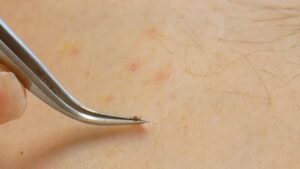There are a number of things you can do to not get Lyme disease. You could move to live in a place where there are no ticks, or where they aren’t infected with the Lyme bacteria. This is a very effective strategy – I’ve used it to avoid being bitten by a hippopotamus for the last thirty years (and counting). Unfortunately it would exclude you from living in some great places like Massachusetts (where Tufts is) or, er, Connecticut. If you can’t move out of a Lyme infested area, there are generally two kinds of thing you can do to try to protect yourself and your family—you can protect yourselves directly, and you can try to change your environment to reduce the risks.
Protecting yourself
The key thing you can do is to avoid deer ticks (only deer ticks can pass on Lyme disease). People who stay inside all day watching Jeopardy re-runs are very unlikely to get Lyme, as we’ve discovered during COVID lockdowns. However, this is bad for your health in other ways and is not recommended. At least change the channel now and again. When you’re outside, try to avoid areas where ticks like to wait for their next meal: tall grass, leaf litter, bushes. Doing things like wearing your pants tucked into their socks can help ticks from reaching your skin but e ven we admit it’ll make you look kind of a doof.
ven we admit it’ll make you look kind of a doof.
Insect repellents can help prevent ticks from attaching. Ones containing DEET or picaridin definitely can ward off ticks, but you should pay attention to the manufacturer’s guides for how often to reapply as sometimes you need to reapply more frequently than you would for mosquitos. There are also plant-based repellents like citronella (they tend to be marketed as being more “natural”) but they’re generally less effective and work only for very short periods of time. You can buy clothing with a tick-killing agent called permethrin embedded in the fabric. Clothing that comes pretreated with permethrin can survive many washings (50 to 70). You can also buy permethrin and treat your own (non-doofy) clothes with it yourself, but then it usually lasts less than 10 washes.
One of the easiest things to do is to shower within a couple of hours after you have been outside. Ticks take a little time wandering around your body to find a place they want to bite and if you shower, you’ll probably wash them off before they’re really attached. The other thing you can do is to do a “tick check”. This involves inspecting every inch of your body after coming in for the night to look for ticks. This works well because even after the tick bites and attaches, it usually takes some time before they will transmit the Lyme bacteria (>48-72 hrs). Some of the researchers at Tufts swear by this and have never gotten Lyme despite getting bitten a lot because they do tick check religiously every night. However, doing tick checks on grumpy, sleepy children at the end of the day can be pretty annoying for everyone involved. It’s also not that easy to check EVERY inch of your own body, so having a partner who’s willing to inspect your head/back/butt helps a lot.
If none of this works and you find a deer tick on your body you should try to remove it as soon as possible. We recommend using tweezers. A link to a video on how to remove it is included here.
If you think that the tick has been attached for more than 48 hours and/or looks like it’s fed, there is still one more thing you can do. You can contact your doctor and ask for a dose of an antibiotic called doxycycline. A single dose of the medication can reduce the chance that you develop Lyme disease. However, you could also just choose to watch the site of the bite (after removing the tick) for the development of the erythema migrans rash and start treatment only if you develop symptoms.
Protecting your environment.
There are certain things that homeowners can do to change their environment and reduce their exposure to ticks. Getting rid of leaf litter, long grass, and wood piles can reduce tick numbers by getting rid of their favorite hideouts.
Spraying your yard with a tick killing agent like permethrin can reduce the numbers of ticks in an area but, according to a study by our CDC, it is not certain that it reduces your chance of getting Lyme. Products that kill ticks on mice have also been shown to be effective in reducing ticks around the house. These cotton wool balls or shredded paper coated with a tick killing agent – the mice find them, use them to build a bed, and the ticks die when they sleep in them. Because mice tend to find a home and stay there, it can be pretty effective in reducing ticks around your house. The only downside is that you’re helping the mice to build a nice place to live in your own house…


